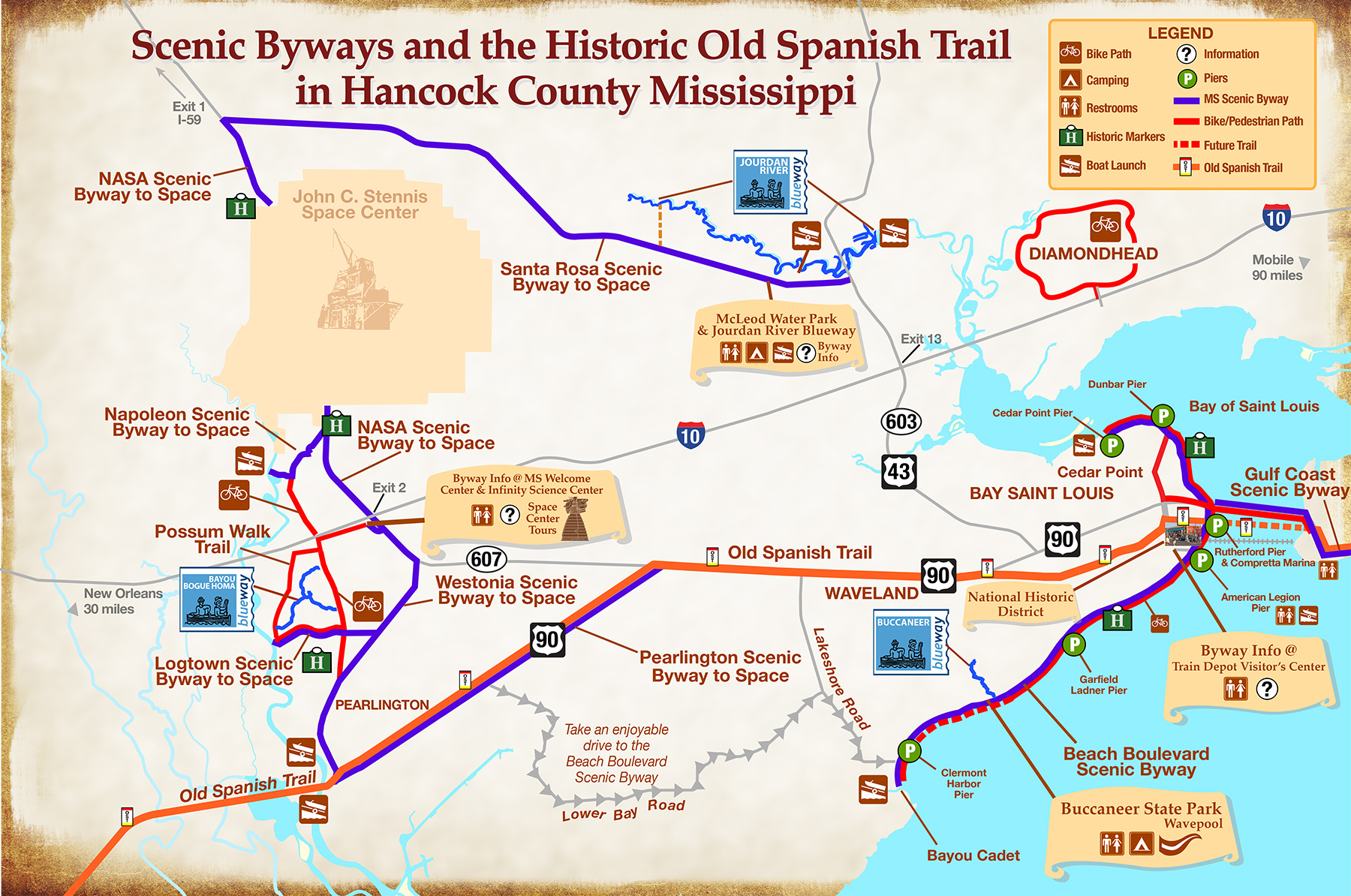

Welcome to the Beach Boulevard Scenic Byway. Formerly known as Old Highway 1, the scenic byway parallels the Hancock County coastline for 13 miles from its northern tip at Cedar Point in Bay St. Louis, crosses U.S. Highway 90, then travels through the National Historic District.

This section of the Beach Boulevard byway features a picturesque drive through the quaint communities of Bay St. Louis, Waveland and Clermont Harbor. It runs along the scenic sand beach and includes a three-mile walking and biking trail of downtown areas.

The Logtown byway presents a picturesque drive that winds through acres of pine plantation, hardwood trees, and live oak-covered roadways that capture scenic vistas all along the route leading to the now extinct town of Logtown. Logtown is both beautiful and peaceful.

Although a short drive, the Napolean byway takes visitors on an interesting tour of the now extinct town that is laced with scenic beauty. Napoleon’s first European settlement was in 1767 by Jean Claude Favre, and the area was later owned by his son Simon Favre.

The NASA Scenic Byway to Space is the beginning point of the journey, which encompasses more than 30 miles of land inside the Buffer Zone surrounding John C. Stennis Space Center. INFINITY Science Center is one of Mississippi’s newest attractions.

Located on the Old Spanish Trail, the byway stretches from the town of Pearlington and intersects Highway 607. Along the way, visitors can view pine plantations and an abundance of deer. One unique feature along the byway is a mid-1900’s highway rest area.

The jewel of the Santa Rosa Scenic Byway is McLeod Park, which was created under the President Nixon initiative to convert federal land to state parks. It’s a recreational haven and is full of camping sites, pavilions, boat launches, nature trails, and swimming areas.

Westonia was a sawmill town named for Horatio Weston. The drive on this scenic byway provides a spectacular view of thousands of acres of pine plantation with sporadic hardwood trees, including live oaks. This byway honors those families that gave up their homes.

On April 7, 1798, Congress of the United States created the Mississippi Territory. At the time, this territory made up the states of what are now Mississippi and Alabama. During the early 1800’s, settlement along the Mississippi Coast was quite sparse. But, between 1813 and 1816, the territory was open to those seeking to settle in a new area. Primarily Anglo Saxon Protestants, most moved to areas along the Mississippi Coast from Virginia, Tennessee, Georgia, and the Carolinas.
Following the Civil War, a railroad was completed which stretched in between New Orleans and Mobile. During this time, many resorts and beautiful beach homes sprang up along the coast. families would escape the illnesses and mosquitoes which plagued the city by travelling to Bay St. Louis and staying over the summer.
In 1915, the concept of the Old Spanish Trail was conceived. This route would be the shortest distance from the Atlantic Ocean (St. Augustine, FL) to the Pacific Ocean (San Diego, CA). This road ran right through Mississippi along the current US Highway 90 and was fully completed by 1929. It stretched over 2,700 miles. The 1923 Rand McNally Automobile Book describes the trail: "Along the Old Spanish Trail are the riches of history, legend, sentiment and natural beauty. And throughout the route there are members of the Old Spanish Trail Association who will find pleasure in making your acquaintance."
Let’s fast forward to 1963 with the opening of NASA’s Stennis Space Center. This endeavor brought on incredible economic development to the area and still assists in sending astronauts into space today. In 1990, Mississippi legalized gambling as long as the casinos were on navigable waters. This addition brought forth tens of thousands of jobs which in turn caused housing prices to increase, and better economies for cities along the Mississippi Gulf Coast.
Over the past 200 years and more, Hancock County has suffered its share of various natural disasters, most recently being Hurricanes Camille (1969) and Katrina (2005). Though destruction was vast, the county and towns have been fully restored to their glory days. Today, residents and tourists enjoy the serene, relaxed, down home feel that Hancock County has to offer. In 2017, the year of the state’s bicentennial, reminds every one of the resilience of the people, places, and history of the region. With a strong military heritage and a pride for calling this area home, over 45,000 residents agree that life got better in Hancock County.


For more information on Hancock County and all it has to offer, visit www.hancockchamber.org or www.hancockmsmyhome.com.